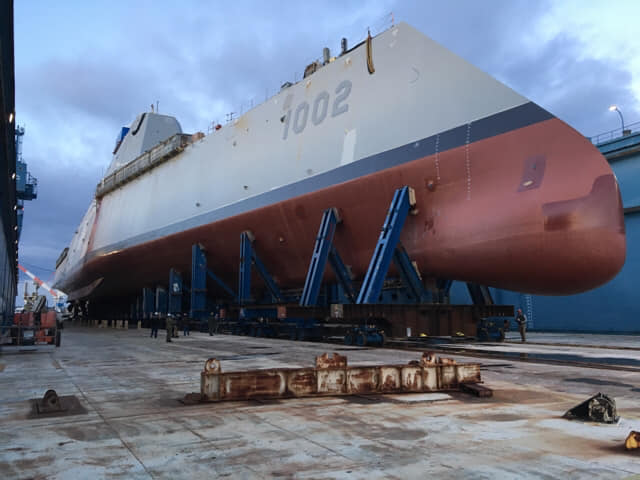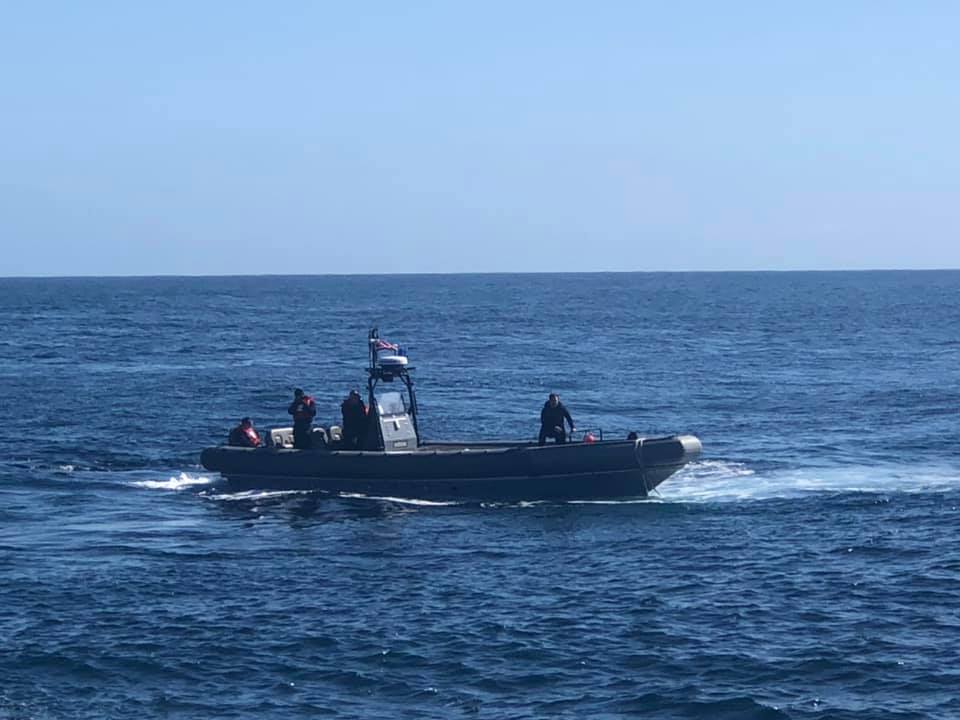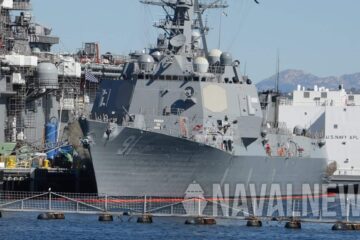The U.S. Navy has Working Plans for these Warships
NAVSEA and the U.S. Navy are exploring the option of rounds for the 155mm Armored Gun System (AGS) and adding a Hypersonic missile variant to the 80 Mark 57 Vertical Launch System (VLS) cells, a larger variant of the Mark 41 VLS. Through Open-Source Intelligence websites, more information can be deferred regarding these three stealthy, unique, one-of-a-kind high-tech tumblehome hull warships as a follow-up to the previous Naval News articles on the Zumwalt destroyers.
The DDGs 1000s’ Early 2021 status
“Make no mistake about it, these three ships will be mainstays of a powerful maritime presence in the Western Pacific.”
RADM Paul Schlise, USN, Director, Surface Warfare (N96) at SNA 2021 Virtual Symposium
According to NAVSEA, these three stealthy high-tech Zumwalt destroyers have changed their missions from Land Attack to Surface Warfare, otherwise known as the sinking of other ships, due to the lack of available production rounds for their 155mm (Land Attack) Armored Gun Systems’ (AGS) magazines, making the 155mm AGSs still in the inactive state as of January 2021. The original intended 155mm long-range attack projectiles just cost too much, in the hundreds of thousands of dollars per round, and hence the U.S. Navy canceled the AGS shell program.
The Zumwalts will carry the $1 million each Maritime Strike Tomahawk reprogrammable in-flight cruise missile, Block Va, with a 1,000+-mile range and a new seeker and warhead. According to Admiral Michael Gilday, USN, Chief of Naval Operations at SNA 2021, the U.S. Navy plans to incorporate Hypersonic missiles to the nuclear Virginia-class attack submarine fleet first, and then on the DDG 1000 destroyers. The three Zumwalt destroyers should be the first surface warships to possess Hypersonic missiles due to their larger Mk 57 VLS cells. Breaking Defense confirms this plan of action in their February 2021 article.
Admiral Gilday also discussed incorporating lasers onto surface warships with the deadline goal of having both lasers and Hypersonics with Initial Operating Capability by 2025. To which Congressman Joe Courtney, Chairman, House Armed Services Subcommittee on Seapower and Projection Forces added that when it comes to next-generation weapons for the Zumwalts [think railguns, 155mm smart GPS extended range rounds, 155mm Hypervelocity (HVP) rounds, or new longer-range missiles], the Biden Administration will have to address this as some ideas worked and some ideas didn’t on the DDG 1000s [the Congressman didn’t elaborate].
Naval News inquired Naval Sea Systems Command’s (NAVSEA) Office of Corporate Communication about the possibility of using new rounds for the 155mm Armored Gun Systems. Alan Baribeau of NAVSEA replied via email in February 2021:
“[The] Navy continues to consider all options to include development of a round compatible with AGS or repurposing the available space should the gun be removed in a future availability.”
NAVSEA also stated that, “DDG 1000 successfully conducted the MK 46 [Mod 2 30mm Bushmaster] Structural Test Fire (STF) [on] 16 May 2020 on Point Mugu Sea Range marking first-in-class large caliber firing of ammunition from a ZUMWALT-Class shipboard weapons system. DDG 1000 successfully executed the first live-fire test of the MK 57 Vertical Launching System with a Standard Missile (SM-2) on the Naval Air Weapons Center Weapons Division Sea Test Range, Point Mugu, 13 October 2020, demonstrating its capability to detect, track and engage Anti-Ship Cruise Missile threats.” RADM Paul Schlise also said at SNA 2021 that the test firings proved the DDG 1000 Zumwalt’s combat effectiveness and that the USS Michael Monsoor (DDG 1001) and USSLyndon B. Johnson (DDG 1002) are not far behind. Furthermore, the U.S. Navy is exploring a range of options to increase capabilities, including upgrades to major sensor systems and weapons.
RADM Schlise also alluded to improved Standard and Tomahawk missile lethality:
“We’re interested in moving lethal capability out of VLS cells so we free up these cells for more long-range offensive firepower missions that distributed lethal sea control and power projection capability that CNO [Gilday] spoke of. And we’re moving to get bigger VLS cells to carry bigger, faster, longer-range missiles. It’s not a question of if we’re going to do it. It is a question of how quickly.”
Rear Admiral Schlise did mention that the U.S. Navy does not plan to use the DDG 1000’s tumblehome hull as the basis for the future DDG(X) destroyer replacement, citing that a totally new hull and power plant system is required for the DDG(X) to power future systems that haven’t yet matured.
NAVSEA’s Mr. Tom Rivers, Executive Director, PEO Ships for Amphibious, Auxillary, and Sealift said that the DDG 1002, USS Lyndon B. Johnson, is 97% complete and that the other two Zumwalts are undergoing testing as of mid-January 2021.
Additional Information on the Zumwalt-class Guided-missile Destroyers
Through Open-Source Intelligence, U.S. Navy’s DDG 1000, 1001, and 1002 Facebook photos, and from official NAVSEA correspondence, Naval News is able to comment a little more on the capabilities of the three DDG 1000 warships.
NAVSEA replied to the question on if the Zumwalts will receive new SPY radars and sensors:
“The Navy is exploring several alternatives to sustain air and surface search capability aboard the Zumwalt-class ships but no decision has been made at this time.”
“A full ship quarter-scale Underwater Explosion (UNDEX) whipping test series was conducted in 2005 to validate the design approach and ruggedness of the hull structural design. The tests demonstrated the design capability of the tumblehome hull against design and threat level scenarios,”
Naval News also asked about the stanchions because some may have believed that they were stealthy pop-up stanchions…they are not and do not retract into the hull and thus have to be manually emplaced:

The Zumwalt-class guided-missile destroyers have an Anti-terrorism self-protection duty in the form of carrying portable and removable pedestal-mounted 7.62mm M240 medium machine guns on the deck and .50cal M2HB heavy machine guns positioned through removable hull hatches along the sides. There appears to be three removable hatches around the bow to the first 155mm AGS, a large hatch amidships, two hatches at the stern sides below the helicopter landing pad, and two hatches facing the rear flanking the RHIB doors. Removable machine guns are often deployed when the destroyer is sailing near the coast, in the littorals, or docked at a port for sentry and close-in defensive security reasons.
Official U.S. Navy photos posted on Facebook also showed sailors armed with M4 5.56mm carbines and M240 machine guns for Anti-terrorism land-assault roles, but NAVSEA will not comment on other weapons in the sailors’ armory such as Anti-tank rocket launchers and missiles, grenade launchers, sniper rifles, miniguns, or Stinger Short-range Air Defense (SHORAD) missiles. The Zumwalts are not known to have 20mm Phalanx Close-in Weapons System (CIWS) or RIM-116 Rolling Airframe Missiles (RAM) for automatic Anti-missile defense. The two 30mm Mk 46 Mod 2 Bushmaster Close-in autocannon guns positioned over the hangar are used against small surface and slow aerial targets.
The bow of the USS Michael Monsoor (1001) has three removable hatches that allow for the emplacement of lookouts or .50cal machine guns. A gun is sticking out to the left of “1001” and at the rear stern corner. The two extendable poles, bow and superstructure, are for pop-up sensors and often deploy when the destroyer is in the littorals or close to the coast. Photo: DDG 1001 Facebook USS Lyndon B. Johnson (DDG 1002) shows off the three small removable hatches (two square ones above “1002” and a larger rectangle hatch to the left) for lookouts and the mounting of machine guns. These hatches are repeated for the other side of the bow. Photo: USS Lyndon B. Johnson Facebook

USS Lyndon B. Johnson’s (DDG 1002) tumblehome hull shape is shown to great effect in this 2018 photo. The wave-piercing hull performed well in the Zumwalt’s (DDG 1000) Arctic voyage to Alaska in March 2019. The bulbous front bow contains the Multifunction sonar. Photo: DDG 1002 Facebook Although still under construction and missing its SPY radar panels and sensor ball pedestals, USS Lyndon B. Johnson’s stealthy angled superstructure is shown to great effect in August 2019 photo, clad in composite material tiles. According to NAVSEA, “The ZUMWALT program developed multiple paints to prevent corrosion, Ultraviolet, and other damage to the composite deckhouse, steel hull, exterior decks, and apertures. The ZUMWALT paint scheme was selected to aesthetically match the hull paint to the lighter color composite superstructure.” Photo: DDG 1002 Facebook One of two electric, Advanced Induction Motors (AIM) that drive the destroyer’s two propeller shafts without the need for transmissions or complicated gears. The electric motors have about 90% efficiency, losing only 10% of their energy as heat. Photo: DDG 1001 Facebook The view of the open helicopter hangar doors. Zumwalts can accommodate one MH-60R and one Vertical Take-off UAV such as the MQ-8 Fire Scout. Note the two 30mm Mk 46 Mod 2 turrets above the hangar and the control room windows above the open doors. Open covers of the Mk 57 VLS cells line the perimeter of the flight deck and act as an armored shield to protect the interior crew compartments inside the hull. The flight deck rails are the Recovery Assist, Secure and Traverse System (RAST) that can accommodate a wide range of helicopters up to Sea State Six. Photo: DDG 1001 Facebook One of two 11m RHIBs that deploy from the stern ramp for Visual Board Search and Seizures, inspections, local enforcement and patrols, Search and Rescue, and Anti-Terrorism duties. According to the Navy, the 11m has a crew of three and can carry eight passengers at speeds of 45 knots with a range of 200 nautical miles (370 kilometers). Beam is 10 feet 7 inches (3.2 meters) and Displacement is 17,400 lbs (7,892 kilograms). Draft is 2 feet 11 inches (0.9 meters). Photo: DDG 1001 Facebook One of two 11m RHIBs aboard the Zumwalts that show the sensor bar with Furuno™ X-Band Doppler Radar that provides fast-track targeting, target analysis, and navigation data, a siren, a blue pursuit light, air horns, and the antenna farm. Photo: DDG 1001 Facebook Stern view of Michael Monsoor (DDG 1001) showing the RHIB ramp. A Tactical Towed-Array Sonar System deploys from the Starboard (two squares) and a NIXIE torpedo decoy from the Port (small hole). Note the two M240 7.62mm medium machine guns on the corners of the helicopter landing deck and the open hatches flanking the RHIB doors that might mount .50cal machine guns. Photo: DDG 1001 Facebook















